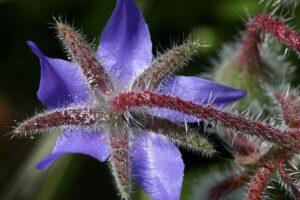The borage herb has a long history of use in traditional medicine. The leaves and flowers are used to make teas, tinctures and extracts. It is said to have a number of health benefits, including the treatment of respiratory problems, skin conditions and digestive disorders.
 Herbalists today believe borage to be a diuretic, demulcent and emollient.
Herbalists today believe borage to be a diuretic, demulcent and emollient.
Infusions and decoctions are taken to relieve fevers, bronchitis, diarrhea and other ailments. It cleanses the blood, promotes perspiration and is used in cases of arthritis and infections of the respiratory tract. Poultices made from the leaves are cooling and soothing to external inflammations and swellings. It also can be used cosmetically to refresh tired skin.
Folklore:
In days of old, borage was sometimes added to a drink and given to prospective husbands to give them the courage to propose marriage and it’s reputation for invoking courage goes back a long way. It was also used to “cheer the heart and lift the depressed spirits“… “for the comfort of the heart, to drive away sorrow and increase the joy of the mind”. (A Modern Herbal– that’s quite the reputation!)
FDA Warning:
Contains pyrrolizidine alkaloids, which can cause liver damage and carcinogenic effects.
Constituents:
The herb contains tannin, mucilage, saponin, malic acid and potassium nitrate. These constituents account for the usefulness of the herb and are thought to be the flavonoids, including quercetin and kaempferol. These compounds are believed to have anti-inflammatory, anti-bacterial and anti-viral properties.
The Plant:
The borage herb is a member of the Boraginaceae family and its scientific name is Borago officinalis.
It is an annual, self seeding plant that has many leafy branches of hollow stems covered with stiff, white hairs. It is native to Europe, Asia Minor and Africa. It was naturalized in Great Britain and is widely cultivated in North America.
A hardy herb that can grow even in poor soil. It has hairy, blue-green leaves and produces small, star-shaped blue flowers that bloom from June to August.
The borage herb is a popular choice for gardens as it is easy to grow and is attractive to bees.
This annual herb is also commonly known as starflower, bee borage and bugloss. It is native to the Mediterranean region but it is now cultivated in many other parts of the world.
Preparations of Borage
Tea: 1 teaspoon borage herb per cup of boiling water, steep for 10 minutes. When steeped in water, it imparts a coolness to it and a faint cucumber flavor, and compounded with lemon and sugar in wine, and water, it makes a refreshing and restorative summer drink.
Tincture: 1:5 borage herb in 50% alcohol, take 2-3 ml (0.4-0.6 teaspoon) three times daily
Extract: 1:1 borage herb in 45% alcohol, take 2-3 ml (0.4-0.6 teaspoon) three times daily
Borage can also be eaten fresh or cooked.
Young borage can be cooked like spinach.
Use the leaves wherever you want a cucumber flavor – fish sauces or white aspics, in salads, soups and stews.
The flowers can be used to decorate cakes and desserts.
The fresh herb has a cucumber-like fragrance.
Recipe:
It is traditional in some fruit punches and the choice blue star-like blooms are beautiful floated in punches and lemonades or used in food garnishes.
Fruit Punch
Boil for 10 minutes:
1-1/4 Cups sugar
1-1/4 cups water
Add:
2-1/2 cups strong hot tea
Cool the mixture. Add:
1 cup crushed pineapple
2-1/2 cups strawberry juice (or other non-citrus fruit juice)
Juice of 6 lemons
Juice of 7 oranges
Chill for 1 hour. Add sufficient water to make 4 quarts.
Immediately before serving add:
1 quart carbonated water
Pour over ice in a punch bowl.
Add Borage flowers as a garnish.
Borage Dosage
For respiratory problems: 2-3 grams of herb three times daily
For skin conditions: 2-3 grams of herb three times daily
For digestive disorders: 2-3 grams of herb three times daily
Precautions:
The herb is a safe and effective natural remedy for many common health problems. However, as with any herbal remedy, it is important to speak to a qualified healthcare practitioner before use.

 Herbalists today believe borage to be a
Herbalists today believe borage to be a